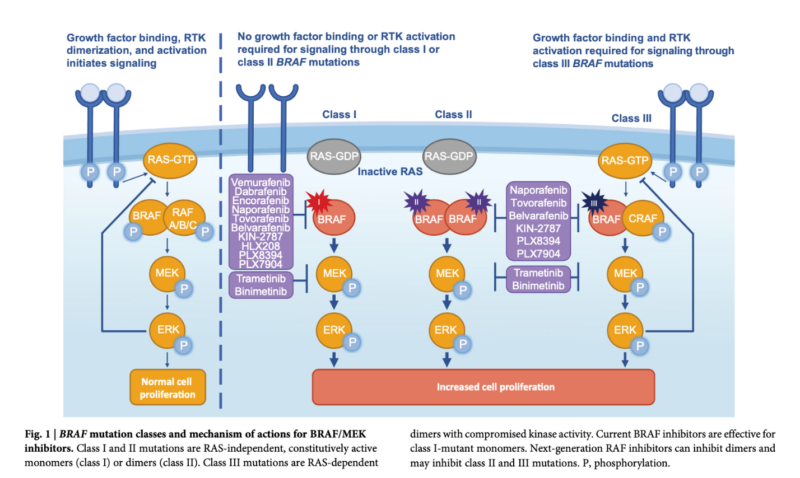Addressing BRAF V600E in Metastatic Non-Small Cell Lung Cancer
Authors: David Planchard, Rachel E. Sanborn, Marcelo V. Negrao, Aria Vaishnavi and Egbert F. Smit
Published in npj Precision Oncology, on April 16, 2024
Introduction:
The BRAF V600E mutation is a key target in metastatic non-small cell lung cancer (NSCLC), appearing in about 1-2% of cases. This mutation triggers the MAPK signaling pathway, fostering unchecked tumour growth and survival. This review offers an in-depth look at the current treatment options, challenges, and new therapies for managing BRAF V600E-mutant metastatic NSCLC, with a focus on enhancing patient outcomes and overcoming drug resistance.
Design/Methods:
The article is a literature review, synthesizing findings from a spectrum of sources to fully capture the progression of treatment for BRAF V600E-mutant metastatic NSCLC. It incorporates insights from pivotal clinical trials that test the efficacy of both monotherapies and combination therapies, as well as retrospective studies that provide long-term outcomes and preclinical research that offers a glimpse into future therapeutic directions.
What We Learned:
- BRAF V600E mutations are predominantly found in adenocarcinomas and are not strongly associated with specific patient characteristics like age, ethnicity, or sex. However, smoking history may be linked to BRAF mutations.
- BRAF mutations are classified into three classes based on dimerization status, RAS dependence, and kinase activity level. Class I mutations, including BRAF V600E, confer constitutive BRAF kinase activity and are effectively targeted by currently approved BRAF inhibitors.
- Classification of BRAF Mutations: BRAF mutations are categorized into three classes, which differ by their mechanism of activation and response to treatments:
- Class I Mutations: Including BRAF V600E, these mutations lead to constitutive activation of BRAF kinase independent of RAS activation and are effectively targeted by currently approved BRAF inhibitors.
- Class II Mutations: These result in BRAF activation that is less dependent on RAS compared to Class I but still involves dimerization with other RAF proteins. These mutations often lead to intermediate levels of kinase activity and may require different therapeutic strategies that target both monomers and dimers.
- Class III Mutations: Characterized by low or absent kinase activity, these mutations depend heavily on RAS for activation and often result in only mild activation of the MAPK pathway. Targeting these mutations can be challenging and may involve novel approaches that address upstream activators or bypass signalling mechanisms.
- Guidelines recommend broad-based molecular testing, including BRAF, for all advanced non-squamous NSCLC patients. Polymerase chain reaction (PCR) and next-generation sequencing (NGS) are commonly used testing methods.
Treatment Landscape:
- BRAF Inhibitor Monotherapy: Vemurafenib and dabrafenib have demonstrated efficacy in BRAF V600E-mutant NSCLC but are associated with acquired resistance and paradoxical activation of the MAPK pathway.
- BRAF/MEK Inhibitor Combinations: The addition of MEK inhibitors, such as trametinib and binimetinib, has improved response rates, progression-free survival (PFS), and overall survival (OS) in clinical trials (e.g., dabrafenib plus trametinib: ORR 63-64%, median PFS 10.2-10.8 months, median OS 17.3-18.2 months; encorafenib plus binimetinib: ORR 46-75%, median PFS 9.3 months-not reached, median OS not reached).
- Immunotherapy Combinations: Combining BRAF/MEK inhibitors with immunotherapy (e.g., anti-PD-1/PD-L1 antibodies) may produce synergistic anti-tumor effects, although tolerability remains a concern.
- Next-Generation BRAF Inhibitors: Drugs like naporafenib, tovorafenib, and belvarafenib are designed to target BRAF dimers and overcome resistance mechanisms. Preclinical and early clinical data suggest potential efficacy against non-V600E mutations.

Key Takeaway Messages:
- Identification of BRAF V600E mutations is crucial for guiding targeted therapy selection in metastatic NSCLC.
- BRAF/MEK inhibitor combinations represent the current standard of care for BRAF V600E-mutant metastatic NSCLC, providing durable responses and improved survival outcomes.
- Emerging treatments, such as next-generation BRAF inhibitors and immunotherapy combinations, hold promise in overcoming resistance mechanisms and expanding therapeutic options for BRAF-mutant NSCLC patients, including those with non-V600E mutations.
- Ongoing research efforts are needed to address unmet needs, including better management of brain metastases, understanding resistance mechanisms, and optimizing treatment sequencing for BRAF V600E-mutant metastatic NSCLC.
Summary by Amalya Sargsyan, MD
BRAFV600E-mutant metastatic NSCLC: disease overview and treatment landscape
About OncoDaily
OncoDaily was founded in 2023. It is a US-based oncology media platform, which features the latest news, insights, and patient stories from the world of oncology. Within a short period of time it became one of the leading oncology media platforms globally.
OncoDaily gathers content from various sources, including social media posts from renowned oncologists from all over the world, news from oncology societies and cancer centers, patient and survivor stories, and career-related information for professionals.
The mission of OncoDaily is to empower patients, survivors, and professionals with the knowledge and inspiration they need to fight cancer. The motto of OncoDaily is “Cancer doesn’t take a day off – neither do we”.
